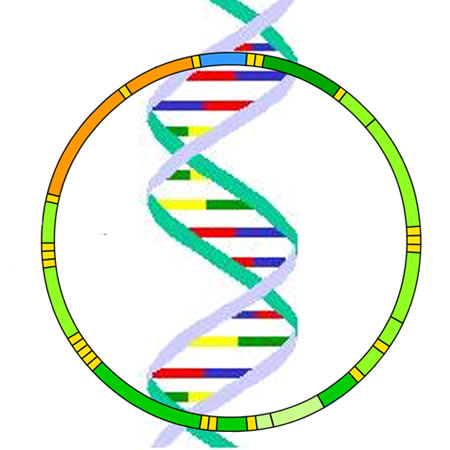 |
| Mitochondrial DNA |
Plant cells have three sets of DNA to code for proteins: one set in the chromosomes of the nucleus, another in the chloroplasts, and a third genome in mitochondria. The mitochondrial genomes of higher plants are larger than those of animals and form a complex series of linear and circular molecules of different sizes.
Mitochondria play an essential role in the generation of energy in eukaryotic cells. Mitochondria are the organelles that are the main “chemical factories” of the cell where cellular aerobic respiration—using the Krebs (citric acid) cycle and respiratory electron transport to produce NADH (nicotinamide adenine dinucleotide) and ATP (adenosine triphosphate)—occurs.
In the light microscope, mitochondria look like short rods or thin filaments about 0.5 to 2 microns long. A mitochondrion is made up of a smooth outer membrane and an inner membrane that is folded into tubular shapes called cristae. Many aerobic respiration reactions are catalyzed by enzymes that are bound to mitochondrial membranes.
  |
Other reactions occur in the space between the inner and outer mitochondrial membranes. Cells may contain several hundred mitochondria. Cells that are dividing and cells that are metabolically active need larger amounts of ATP and usually have large numbers of mitochondria.
Size and Structure
All eukaryotic cells except some primitive protozoans contain mitochondria. All mitochondria contain their own DNA(genomes). There are typically between twenty and one hundred copies of the mitochondrial genome per mitochondrion.
The mitochondria of multicellular animals contain genomes of 14 to 20 kilobases (kb), present as single circles. The mitochondrial DNA of some organisms, such as some protozoa, algae, and fungi, is organized in linear molecules with ends of chromosomes (telomeres) much like nuclear chromosomes.
In contrast, the mitochondrial DNA of higher plants is larger and more complex—from 200 to 2,500 kb—and is present in many different molecules. The size and organization of the mitochondrial genome vary widely from one plant species to another. Electron micrographs of mitochondrial DNA show linear and circular DNAs of a variety of sizes and complex, branched molecules that are larger than the size of the genome.
Cloning the mitochondrial DNA and comparing the sequences of the clones show that the entire complexity of a plant mitochondrial genome can be represented as a “master circle.” Also, it has been learned that sequences are repeated on the master chromosome. The repeated sequences differ for different plant species.
A series of recombination events between these identical repeated sequences results in a series of rearrangements of mitochondrial DNA and forms the complex, multiple molecules of varying sizes that are the physical structure of the plant mitochondrial genome.
Adding to the complexity of mitochondrial DNAs in higher plants is the fact that some plants, such as corn, contain extra chromosomal mitochondrial nucleic acids. Plasmid-like DNAs (circular double-stranded molecules) and double-stranded and single-stranded RNAs have been found in some corn strains.
Genes Encoded by Mitochondrial DNA
In addition to containing their own genomes, mitochondria contain enzymes for DNA replication and transcription, and ribosomes and transfer RNAs for protein synthesis. (Transfer RNA, or tRNA, carries the building blocks of proteins, called amino acids, to the ribosome, where they are assembled according to the instructions found in messenger RNA.)
The ribosomes of mitochondria are different from those of chloroplasts and the cytoplasm, using a slightly different genetic code (a sequence of three bases that codes for a particular amino acid). Mitochondrial genomes code for all of the ribosomal RNAs found in mitochondria and for most of the tRNAs. Mitochondria make only a small number of proteins that are needed for electron transport and ATP production.
The other proteins needed in mitochondria are coded by nuclear DNA, translated in the cytoplasm of the cell, then transported into the mitochondria. Plant mitochondria do not encode a full set of tRNAs, and some are imported from the cytoplasm.
Even though the mitochondrial genome of higher plants is much larger than that of animals, the plant mitochondrial genome codes for only a few more genes. The mitochondrial genome of Arabidopsis has been sequenced and contains thirty-two protein-coding genes, twenty-two tRNA genes, and three ribosomal RNA genes.
   |
Exchange of DNA
Mitochondrial DNA from plants also differs from that of animals in that mitochondrial DNAs contain segments of DNA that originally were in nuclear and chloroplast DNAs. There appear to have been exchanges of DNAs between all three of the higher plant genomes.
There is evidence that mitochondrial genes have been transferred to the nucleus and some mitochondrial tRNAs appear to be of chloroplast origin. Changes in nuclear genes have been shown to lead to changes in the copy number of the different mitochondrial DNA configurations.
RNA Editing
Mitochondria and chloroplasts contain the biochemical machinery to alter the sequence of the final messenger RNA (mRNA) product in a process called RNA editing. The most common editing is changing a cytosine to a uracil (two of the bases found on the “rungs” of DNA molecules and which are responsible for determining the nucleotide sequences that form the genetic code).
Inheritance of Mitochondrial DNA
Given the complex branched network of plant mitochondrial DNA, it is difficult to see how the inheritance of a complete genome is ensured. It is still not clearly understood how this complex network of DNAs is passed to daughter cells in away that assures that all of the genetic information is maintained.
